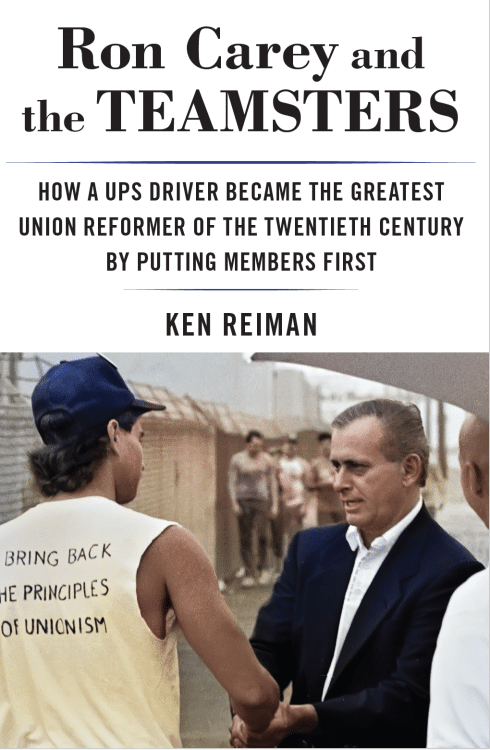Ron Carey and the Teamsters: How a UPS Driver Became the Greatest Union Reformer of the 20th Century by Putting Members First
By Ken Reiman
320 pages / 25$ / 978-1-68590-058-8
Steve Early for New York Labor History Association
Ken Reiman and Dan La Botz are both New York City veterans of the Teamster reform movement, in different eras. They have just published books which draw on their rank-and-file experiences and recall the myriad challenges faced by Ron Carey, the ex-Marine from Queens who battled gangsterism and corruption throughout his career in the International Brotherhood of Teamsters (IBT).
Reiman’s personal connection to the subject matter of Ron Carey and the Teamsters was formed while working for United Parcel Service (UPS) as delivery driver. He became a shop steward, Teamsters for a Democratic Union (TDU) member, and union newsletter editor in IBT Local 804, Carey’s home local.
Books about high-profile labor leaders are usually penned by professional writers — either academic historians, labor journalists, or paid flacks. Past accounts of the life and work of John L. Lewis, Walter Reuther, Jimmy Hoffa, Harry Bridges, or Cesar Chavez have run the gamut from hagiographic to constructively critical.
Few have had a biographer whose view of their leadership role is rooted in actual experience as a blue-collar worker in the same industry and union. Reiman’s insights into the workplace culture and organizational politics of the Teamsters– before, during, and after Carey’s presidency, in the 1990s–provide a unique perspective on the challenges of reform leadership and institutional change in any major union….
Scandal Driven Democracy
Reiman’s well-researched and detailed account of Ron Carey’s rise and fall—and La Botz’s fictional rendering of the same tragic events —contain valuable lessons and insights for Teamsters and other union members. Let’s hope that there is an equally talented UAW local union newsletter editor, working in a factory today or in higher education, who similarly aspires to be Shawn Fain’s biographer (or an historian of Unite All Workers for Democracy (UAWD), the TDU-inspired opposition caucus that backed him for UAW president on a broader reform slate two years ago).
After leading a newly mobilized membership in a successful selective strike in the auto industry last year, Fain is now skirmishing with a court-appointed overseer of Solidarity House, over multiple issues. The latter owes his position to the corruption scandals that led to adoption of direct (rather than convention) election of the union’s top officials. In Carey’s case, the referendum election system imposed on the IBT, under the terms of a federal racketeering case settlement in 1989, also enabled him and other TDU-backed candidates to win top leadership roles.
As Reiman reports, the union’s reform faction then faced continuing resistance from well entrenched internal foes. Carey’s crackdown on crooks and leadership perks alienated large sections of the Teamster officialdom. In 1996, the still-powerful local officialdom, which backed two competing “Old Guard” candidates five years earlier, bankrolled a unified $4 million challenge to Carey. It was fronted by a local union lawyer with the most famous last name in Teamsterdom.
James Hoffa, who ended up serving as IBT president for several strike-free decades, masqueraded successfully as a populist critic of a “New Teamster” regime dominated by “outsiders.” Meanwhile, as Reiman documents, some of Carey’s re-election campaign fund-raisers and helpers, hired from outside the union, engaged in criminal misconduct of their own.
This dealt a huge self-inflicted blow to the moral authority and public reputation of Carey’s administration, leading to his removal from office, lifetime ban from the union, and prosecution for perjury (He was acquitted in 2001.)
While these dark legal and political clouds were gathering in 1997, Carey led 185,000 of his fellow UPS workers in the biggest nationwide strike in the last 30 years. The UPS contract campaign, preceding that walk-out, employed membership education and mobilization, labor-community coalition building, and media outreach that the union had never utilized before.
As Ken Reiman shows, that landmark struggle, widely hailed at the time and still fondly remembered today, would not have been possible without a Teamsters president who believed in rank-and-file power—and wasn’t afraid to use it.

Comments are closed.